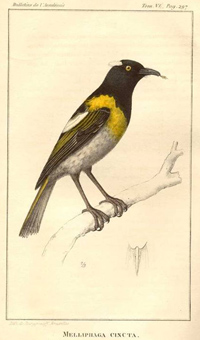
ihi were first described by DuBus, a Belgian naturalist, in 1839. DuBus worked from museum specimens that had been sent to him at the Natural History Museum in Brussels. DuBus placed hihi in the family Meliphagidae, an Australasian group of birds commonly known as honeyeaters. The phylogenetic placement was justified because of the described nectivorous diet and the presence of a brush tipped tongue. There has, however, always been an element of doubt relating to the taxonomic placement of hihi. This is perhaps exemplified by the scientific name Notiomystis cincta which loosely translates to ‘southern mystery’. Early discussion focused on the ‘well developed facial whiskers’ which are thought to be more characteristic of insect specialists.
Work by molecular biologists has confirmed suspicions that hihi are not honeyeaters and have revealed that hihi should be considered the sole representative of an endemic family of New Zealand bird the Notiomystidae.
Resolving what and how distinct hihi are is of importance for both pure and applied biology. Ever-increasing research on Aotearoa New Zealand’s avifauna is highlighting just how unique and distinctive our bird species are. The evolutionary significance of this is perhaps best captured by Jared Diamond’s comment that studying the evolution of New Zealand’s land fauna is as close as we can get to the study of evolution of life on another planet. Of course, understanding a species’ systematics is not only of academic merit because phylogenetic uniqueness weighs into the equation when determining conservation priority.
![]()